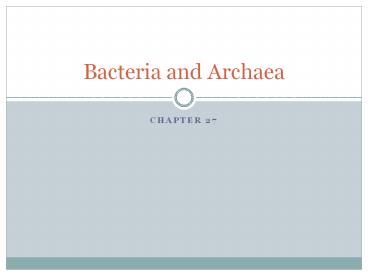Bacteria and Archaea - PowerPoint PPT Presentation
Title:
Bacteria and Archaea
Description:
Bacteria and Archaea CHAPTER 27 Note: Students should review Figure 20.4: Cloning Genes in Bacterial Plasmids Students should review Figure 20.25: Using the Ti ... – PowerPoint PPT presentation
Number of Views:161
Avg rating:3.0/5.0
Title: Bacteria and Archaea
1
Bacteria and Archaea
- Chapter 27
2
YOU MUST KNOW
- The key ways in which prokaryotes differ from
eukaryotes with respect to - Genome
- Membrane bound organelles
- Size
- Reproduction
- Mechanisms that contribute to genetic diversity
in prokaryotes, including - Transformation
- Conjugation
- Transduction
- Mutation
3
Structural Functional Adaptations
- Structural and functional adaptations contribute
to prokaryotic success - Both the domain Bacteria and the domain Archaea
are made up of prokaryotes. - Prokaryotes have NO TRUE NUCLEI or internal
compartmentalization. - The DNA of prokaryotes is concentrated in the
nucleoid region and has little associated
protein. - Relative to eukaryotes, prokaryotes have simple,
small genomes. - In addition to their one major chromosome,
prokaryotic cells may also possess smaller,
circular, independent pieces of DNA called
plasmids.
4
Prokaryotic Shapes
- In general, prokaryotes exist in three common
shapes - Cocci (round)
- Bacillus (rod-shaped)
- Spirilla (spiral)
5
Prokaryotic Reproduction
- Prokaryotes reproduce through an asexual process
called binary fission, and they continually
synthesize DNA.
6
Prokaryotic Structure
- Outside their cell membranes, most prokaryotes
possess a cell wall that contains peptidoglycan. - Gram-positive bacteria have simpler cell walls
with more peptidoglycan. - Gram-negative bacteria have cell walls that are
structurally more complex.
7
Prokaryotic Structure
- The cell wall of many prokaryotes is covered by a
capsule, a sticky layer of polysaccharide or
protein. - The capsule enables prokaryotes to adhere to
other substrate or to other individuals in a
colony. Some capsules protect against
dehydration. - Some prokaryotes stick to their substrate or to
one another by means of hair-like appendages
called fimbriae. - The ability of some prokaryotes to withstand
harsh conditions is attributed to endospores, a
tough wall that forms outside the cell wall.
8
Prokaryotic Motility
- Prokaryotes use appendages called pili that
adhere to each other or to surrounding surfaces. - About half of the prokaryotes are motile, because
they possess whiplike flagella.
9
Genetic Diversity in Prokaryotes
- Rapid reproduction, mutation, and genetic
recombination promote genetic diversity in
prokaryotes - While mutation is the major source of genetic
variation in prokaryotes, there are three
mechanisms by which bacteria can transfer genetic
material between each other - Transformation (the uptake of foreign DNA from
the surrounding environment). - Conjugation (the direct transfer of genes from
one prokaryote to another). - Transduction (the transfer of genes from one
prokaryote to another via a viral vector).
10
Lateral Gene Transfer in Prokaryotes
11
Major Nutritional Modes in Prokaryotes
12
Oxygen Needs in Prokaryotes
- Obligate aerobes cannot growth without oxygen
because they need oxygen for cellular
respiration. - Obligate anaerobes are poisoned by oxygen. Some
use fermentation, whereas others extract chemical
energy by another form of anaerobic respiration. - Facultative anaerobes use oxygen if it is
available, when oxygen is not available, they
undergo fermentation. - Some prokaryotes can use atmospheric nitrogen as
a direct source of nitrogen in a process called
nitrogen fixation. They convert N2 to NH4.
13
(No Transcript)
14
Molecular Systematics Prokaryotic Phylogeny
- Molecular systematics is illuminating prokaryotic
phylogeny. - The first prokaryotes that were classified in the
domain Archaea are known as extremophiles and
live in extreme environments - Extreme Halophiles live in saline environments.
- Extreme Thermophiles live in very hot
environments. - Other Archaea do not live in extreme
environments. - Methanogens use carbon dioxide to oxidize H2 and
produce methane as a waste product.
15
Ecological Importance of Prokaryotes
- Prokaryotes play crucial roles in the biosphere
- Many prokaryotes are decomposers, breaking down
dead organic matter. - Many prokaryotes are symbiotic, forming crucial
relationships with other species. - Some prokaryotes are pathogenic and cause illness
by producing poisons. Antibiotics are chemicals
that can kill prokaryotes. They are NOT
effective against viruses. - Many bacterial plasmids contain resistance genes
to different antibiotics.
16
Human Uses of Prokaryotes
- Prokaryotes are used by humans in many ways
- Prokaryotes are used in bioremediation, removing
pollutants from soil, air, or water. - Includes sewage treatment, oil spill clean up,
and radioactive material precipitation. - Prokaryotes are symbionts in the gut, and can be
used to make vitamins, and assist in digesting
food. - Prokaryotes are used in gene cloning and
producing transgenic organisms. - Prokaryotes are used in a wide variety of food
productions cheese, yogurt, and other products.































